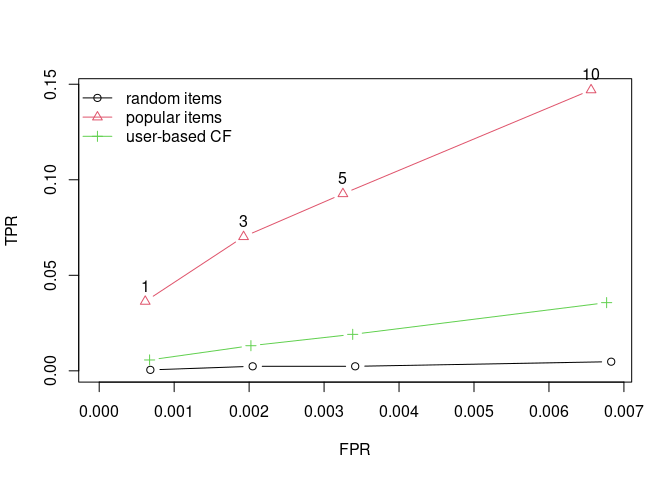Provides a research infrastructure to develop and evaluate collaborative filtering recommender algorithms. This includes a sparse representation for user-item matrices, many popular algorithms, top-N recommendations, and cross-validation. The package supports rating (e.g., 1-5 stars) and unary (0-1) data sets. Supported algorithms are:
For evaluation, the framework supports given-n and all-but-x protocols with
Evaluation measures are:
Stable CRAN version: install from within R with
install.packages("recommenderlab")Current development version: Install from r-universe.
Load the package and prepare a dataset (included in the package). The MovieLense data contains user ratings for movies on a 1 to 5 star scale. We only use here users with more than 100 ratings.
library("recommenderlab")
data("MovieLense")
MovieLense100 <- MovieLense[rowCounts(MovieLense) > 100, ]
MovieLense100## 358 x 1664 rating matrix of class 'realRatingMatrix' with 73610 ratings.Train a user-based collaborative filtering recommender using a small training set.
train <- MovieLense100[1:100]
rec <- Recommender(train, method = "UBCF")
rec## Recommender of type 'UBCF' for 'realRatingMatrix'
## learned using 100 users.Create top-N recommendations for new users (users 101 and 102).
pre <- predict(rec, MovieLense100[101:102], n = 5)
pre## Recommendations as 'topNList' with n = 5 for 2 users.as(pre, "list")## $`0`
## [1] "M (1931)"
## [2] "Braindead (1992)"
## [3] "Charade (1963)"
## [4] "Touch of Evil (1958)"
## [5] "Die xue shuang xiong (Killer, The) (1989)"
##
## $`1`
## [1] "SubUrbia (1997)" "Apostle, The (1997)" "Dead Man (1995)"
## [4] "War Room, The (1993)" "Beautiful Thing (1996)"Use a 10-fold cross-validation scheme to compare the top-N lists of several algorithms. Movies with 4 or more stars are considered a good recommendation. We plot true negative vs. true positive rate for top-N lists of different lengths.
scheme <- evaluationScheme(MovieLense100, method = "cross-validation", k = 10,
given = -5, goodRating = 4)
scheme## Evaluation scheme using all-but-5 items
## Method: 'cross-validation' with 10 run(s).
## Good ratings: >=4.000000
## Data set: 358 x 1664 rating matrix of class 'realRatingMatrix' with 73610 ratings.algorithms <- list(
"random items" = list(name = "RANDOM", param = NULL),
"popular items" = list(name = "POPULAR", param = NULL),
"user-based CF" = list(name = "UBCF", param = list(nn = 3))
)
results <- evaluate(scheme, algorithms, type = "topNList",
n=c(1, 3, 5, 10), progress = FALSE)
plot(results, annotate = 2, legend = "topleft")
A simple Shiny App running recommenderlab can be found at https://mhahsler-apps.shinyapps.io/Jester/ (source code).